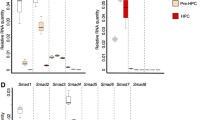Background: To evaluate the influence of hypoxia and molecular events in endothelial and embryonic stem cells.
Materials and Methods: Human umbilical vein endothelial cells (HUVECs) and mouse embryoid body (EB) cells were subjected to hypoxic conditions for different time courses. DNA fragmentation assay, quantification of apoptotic cells by TUNEL assay measured by flowcytometry, and Western blot analysis for the molecular events of apoptosis were performed.
Results: DNA fragmentation could be identified under hypoxic conditions in HUVECs and mouse EBs. The DNA fragmentation increased when the hypoxic interval was extended.
In situ internucleosomal DNA fragmentation-TUNEL assay also found that the percentages of apoptotic cells increased gradually in HUVECs and mouse EBs when the hypoxic interval was extended. Furthermore, the levels of expression of p53 and Bax both increased in hypoxic conditions.
Conclusions: Hypoxia increases both HUVEC and mouse EB apoptosis, which is associated with increase in p53/Bax expression.
Similar content being viewed by others
References
Kajii T, Ferrier A, Niikawa N, Takahara H, Ohama K, Avirachan S. Anatomic and chromosomal anomalies in 639 spontaneous abortuses. Hum Genet 1980; 55: 87–98.
Simpson JL. Genes, chromosomes, and reproductive failure. Fertil Steril 1980; 33: 107–116.
Laurini R. Fetal brain pathology. In: Krujak A CF, ed. The Fetus as a Patient. Carnforth, UK: Parthenon, 1994: 89–106.
Pearlstone M, Baxi L. Subchorionic hematoma: A review. Obstet Gynecol Surv 1993; 48: 65–68.
Nyberg DA, Cyr DR, Mack LA, Wilson DA, Shuman WP. Sonographic spectrum of placental abruption. AJR Am J Roentgenol 1987; 148: 161–164.
Granger JP, Alexander BT, Llinas MT, Bennett WA, Khalil RA. Pathophysiology of preeclampsia: linking placental ischemia/hypoxia with microvascular dysfunction. Microcirculation 2002; 9: 147–160.
Carmeliet P, Dor Y, Herbert JM, et al. Role of HIF-1alpha in hypoxia-mediated apoptosis, cell proliferation and tumour angiogenesis. Nature 1998; 394: 485–490.
Stempien-Otero A, Karsan A, Cornejo CJ, et al. Mechanisms of hypoxia-induced endothelial cell death. Role of p53 in apoptosis. J Biol Chem 1999; 274: 8039–8045.
Hoshi H, McKeehan WL. Brain- and liver cell-derived factors are required for growth of human endothelial cells in serum-free culture. Proc Natl Acad Sci USA 1984; 81: 6413–6417.
Kauma S, Takacs P, Scordalakes C, Walsh S, Green K, Peng T. Increased endothelial monocyte chemoattractant protein-1 and interleukin-8 in preeclampsia. Obstet Gynecol 2002; 100: 706–714.
Muller AM, Cronen C, Muller KM, Kirkpatrick CJ. Comparative analysis of the reactivity of human umbilical vein endothelial cells in organ and monolayer culture. Pathobiology 1999; 67: 99–107.
Keller GM. In vitro differentiation of embryonic stem cells. Curr Opin Cell Biol 1995; 7: 862–869.
Shimizu S, Eguchi Y, Kamiike W, et al. Induction of apoptosis as well as necrosis by hypoxia and predominant prevention of apoptosis by Bcl-2 and Bcl-XL. Cancer Res 1996; 56: 2161–2166.
Itano Y, Ito A, Uehara T, Nomura Y. Regulation of Bcl-2 protein expression in human neuroblastoma SH-SY5Y cells: Positive and negative effects of protein kinases C and A, respectively. J Neurochem 1996; 67: 131–137.
Cheng WF, Hung CF, Chai CY, et al. Tumor-specific immunity and antiangiogenesis generated by a DNA vaccine encoding calreticulin linked to a tumor antigen. J Clin Invest 2001; 108: 669–678.
Cheng WF, Hung CF, Hsu KF, et al. Cancer immunotherapy using Sindbis virus replicon particles encoding a VP22-antigen fusion. Hum Gene Ther 2002; 13: 553–568.
Jennings RB, Ganote CE, Reimer KA. Ischemic tissue injury. Am J Pathol 1975; 81: 179–198.
Harrison-Shostak DC, Lemasters JJ, Edgell CJ, Herman B. Role of ICE-like proteases in endothelial cell hypoxic and reperfusion injury. Biochem Biophys Res Commun 1997; 231: 844–847.
Muschel RJ, Bernhard EJ, Garza L, McKenna WG, Koch CJ. Induction of apoptosis at different oxygen tensions: evidence that oxygen radicals do not mediate apoptotic signaling. Cancer Res 1995; 55: 995–998.
Evans MJ, Kaufman MH. Establishment in culture of pluripotential cells from mouse embryos. Nature 1981; 292: 154–156.
Martin GR. Isolation of a pluripotent cell line from early mouse embryos cultured in medium conditioned by teratocarcinoma stem cells. Proc Natl Acad Sci USA 1981; 78: 7634–7638.
Risau W, Sariola H, Zerwes HG, et al. Vasculogenesis and angiogenesis in embryonic-stem-cell-derived embryoid bodies. Development 1988; 102: 471–478.
Wang R, Clark R, Bautch VL. Embryonic stem cell-derived cystic embryoid bodies form vascular channels: an in vitro model of blood vessel development. Development 1992; 114: 303–316.
Lee YJ, Kang IJ, Bunger R, Kang YH. Mechanisms of pyruvate inhibition of oxidant-induced apoptosis in human endothelial cells. Microvasc Res 2003; 66: 91–101.
Aoki M, Nata T, Morishita R, et al. Endothelial apoptosis induced by oxidative stress through activation of NF-kappaB: antiapoptotic effect of antioxidant agents on endothelial cells. Hypertension 2001; 38: 48–55.
Chen YH, Wu HL, Chen CK, Huang YH, Yang BC, Wu LW. Angiostatin antagonizes the action of VEGF-A in human endothelial cells via two distinct pathways. Biochem Biophys Res Commun 2003; 310: 804–810.
Stempien-Otero A, Karsan A, Cornejo CJ, et al. Mechanisms of hypoxia-induced endothelial cell death. Role of p53 in apoptosis. J Biol Chem 1999; 274: 8039–8045.
Levy R, Smith SD, Chandler K, Sadovsky Y, Nelson DM. Apoptosis in human cultured trophoblasts is enhanced by hypoxia and diminished by epidermal growth factor. Am J Physiol Cell Physiol 2000; 278: C982–988.
Alarcon RM, Denko NC, Giaccia AJ. Genetic determinants that influence hypoxia-induced apoptosis. Novartis Found Symp 2001; 240: 115–128; discussion 128–132.
Shen Y, White E. p53-dependent apoptosis pathways. Adv Cancer Res 2001; 82: 55–84.
Harris AL. Hypoxia–a key regulatory factor in tumour growth. Nature Rev Cancer 2002; 2: 38–47.
Shen Y, White E. p53-dependent apoptosis pathways. Adv Cancer Res 2001; 82: 55–84.
Author information
Authors and Affiliations
Corresponding author
Rights and permissions
About this article
Cite this article
Lee, C.N., Cheng, W.F., Chang, M.C. et al. Hypoxia-induced apoptosis in endothelial cells and embryonic stem cells. Apoptosis 10, 887–894 (2005). https://doi.org/10.1007/s10495-005-2946-0
Issue Date:
DOI: https://doi.org/10.1007/s10495-005-2946-0




